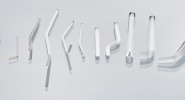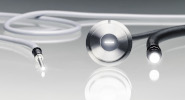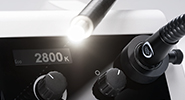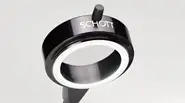Five reasons why glass is best for medical devices
1. Superior light performance
When glass is used to make optical fibers – the basis for flexible and rigid light guides – you can expect the very highest light-delivery performance. The high color rendering index of glass means that the wavelength of light entering and exiting the fiber or light guide changes very little. This gives health care practitioners the most true-to-life color for viewing tissue. The large numerical aperture of up to 1 available from glass fibers also allows more light to enter and travel down the fibers, producing larger fields of view and enabling a smaller fiber bundle to illuminate larger areas. In contrast, due to limiting material characteristics, polymer optical fibers can only achieve a maximum aperture of 0.5.
2. Strong yet bendable
Glass is uniquely strong yet becomes flexible when very thin. This combination of properties means that glass fibers for light guides can be made as thin as 30 microns in diameter (less than half as thick as a human hair). These small diameters enable the tight bending radii that are needed for highly flexible movement in endoscopes. In contrast, the very thin polymer fibers typically have a diameter of 500 microns, and in most cases measure 1 mm (1,000 microns) or more. For imaging applications, individual glass fibers can be as small as 4 microns in diameter, enabling a high pixel resolution. This means that a detailed, clear image can travel from one end of the fiber bundle to the other.
Autoclaving or reprocessing at 134 degrees Celsius, as is the case with endoscopes or rigid fiber-optic dental rods, is easily possible with fiber-optic light guides.
3. Stable at high temperatures
Because glass remains stable at temperatures up to 350 °C, flexible glass fiber bundles or rigid light guides can easily withstand autoclaving sterilization, which reaches 134 °C. This makes glass ideal for light delivery in reusable devices such as dental instruments or endoscopes that need to be cleaned and sterilized. Autoclaving isn’t an option for instruments containing polymer fibers because they generally only withstand temperatures up to 80 °C.
4. More design options
Thanks to the extremely small diameters of glass fibers, a high number of single fibers can fit into a relatively small fiber bundle. This allows complex geometries to be realized with small fiber bundles. When used as a light source for single-use endoscopes, the small diameters of optical fibers let them to be positioned around a camera in a shape that helps reduce camera oversaturation. Glass fiber bundles can also be used to deliver light from a single light source along several smaller branches to multiple locations. Mixing red, green, and blue LED light can be performed with glass fiber bundles to create homogeneous white light at the other end. Because glass fibers are very thin, more of these fit in a bundle of a certain diameter compared to thicker polymer fibers. The higher number of fibers leads to a more homogenized light output.
5. High chemical resistance
Thanks to its high chemical resistance, glass doesn’t interact with cleaning agents, detergents, acids, bases, solvents, or glues. This makes glass components long-lasting and easy to clean. The inertness of glass also means there’s no risk of an allergic reaction because it doesn’t illicit any immune response from the body. Polymers, on the other hand, can react with a variety of chemicals and sometimes cause immune responses in the body. Many polymers can’t be used with low-temperature medical equipment processes such as plasma sterilization because they react to the hydrogen peroxide used in this process.
How do glass fibers conduct light?
Glass fibers are produced from glass core rods using fiber drawing processes and are usually further processed into fiber bundles. A glass fiber consists of a cladding and a light conducting core of glass. The principle of so-called total internal reflection is used to ensure that the light is conducted with as little loss as possible towards the front of the fiber.
This means that the light is not refracted at the interface of the fiber cladding and the fiber core, but completely reflected. This is achieved when the fiber cladding has a lower refractive index than the fiber core. This applies up to a minimum critical angle – which is also the maximum aperture angle of the fiber – at which the light hits the cladding.







